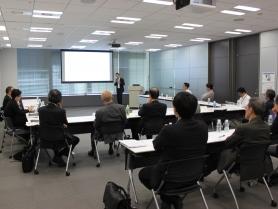Event Report Global Economy
CIGS Workshop "Firms and Markets in Historical Perspectives"
November 30, 2018,
14:00
- 16:00
Venue: CIGS Meeting Room3



 (Mr. Sawada, Mr. Sakai, Mr. Onishi and Mr. Okazaki from the left)
(Mr. Sawada, Mr. Sakai, Mr. Onishi and Mr. Okazaki from the left)
Presenter: Michiru Sawada, Professor, Nihon University
Title: "The Effects of Lender of Last Resort on Financial Intermediation during the Great Depression in Japan"
Presentation slides:
Presentation slidesPDF: 1.07MB
Presentation outline:
The interwar Japanese economy was unsettled by chronic banking instability, and yet the Bank of Japan (BOJ) restricted access to its liquidity provision to a select group of banks, BOJ correspondent banks, rather than making its loans widely available "to merchants, to minor bankers, to this man and to that man" as prescribed by Bagehot (1873). This historical episode provides us with a quasi-experimental setting to study the impact of Lender of Last Resort (LOLR) policies on financial intermediation. The econometric analyses show that the growth rate of deposits and loans was faster for BOJ correspondent banks than the other banks during the bank panic phase of the Great Depression from 1931-1932. Furthermore, the probability of closure was lower for BOJ correspondent banks than the other banks. To address the possible endogenous selection of BOJ correspondent banks, we also instrument it with a bank's geographical proximity to the nearest BOJ branch, which was a major determinant of a bank's transaction relationship with the BOJ at the time. This instrumental variable specification yields qualitatively similar results. Taken together, Japan's experience with LOLR policies during the Great Depression suggests that central banks' liquidity provisions play an important backstop role in supporting the essential financial intermediation services in time of financial stringency.
Presenter: Koji Sakai, Associate Professor, Kyoto Sangyo University
Title: "Capital Market Integration in Prewar Japan"
Presentation slides:
Presentation slidesPDF: 984KB
Presentation outline:
This paper investigates the capital market integration in prewar Japan, using a panel data of prefectural loan rates from 1888 to 1936. Specifically, we apply the method of log t regression and club convergence test proposed by Phillips and Sul (2007) to test the convergence of prefectural loan rates and detect the convergence clusters that follow the heterogeneous transition paths. Our main findings are as follows. In 1901-1926, loan rates of all prefectures converged towards a unique equilibrium, which indicates that the integration of Japanese capital markets progressed. From 1927, however, the prefectural loan rates diverged again, and four different convergence clubs emerged. In other words, the Japanese capital market was segmented again. Restrictive regulations by the Banking Law of 1928 reduced competition in local markets, increased barriers to interregional capital mobility, and thereby impeded capital market integration.
Presenter:
Ken Onishi, Board of Governors of Federal Reserve System
Title: "Compatible Mergers: Assets, Business Area and Market Power"
Presentation slides (Japanese):
Presentation slidesPDF: 1.35MB
Presentation outline:
This paper empirically studies the determinants and consequences of mergers by combining data on the merger waves in the Japanese electricity industry with detailed
plant and firm-level data. Our investigation on determinants of mergers reveals that mergers occur more likely between firms with grater difference in their asset composition and more overlaps in their operating markets. We then ask a question of such observed patterns are driven by cost efficiency and/or higher market power. Our analyses show that larger cost synergies arise when a merger happens among firms with greater differences in asset composition and/or more overlaps in their operating markets. Moreover, the former type of mergers is associated with improvement in asset utilization rates, whereas the latter type leads to higher prices through increasing market concentration. Though there may exist efficiency gain, consumer welfare may be hurt by higher prices, which suggest social welfare requires deep consideration.
CIGS Workshop is a presentation of the progress for the study which CIGS researchers are doing. They take comments from other researchers, advisors, and outside commentators, and they make use of them for their future study.
